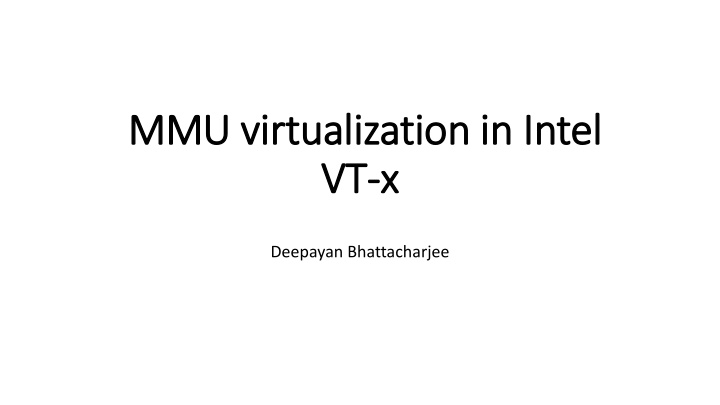



MMU virtualization in In Intel VT VT-x Deepayan Bhattacharjee
VT-x : Motivation • To solve the problem that the x86 instructions architecture cannot be virtualized. • Simplify VMM software by closing virtualization holes by design of Ring Compression. • Eliminate need for software virtualization such as paravirtualization.
VPID: Virtual Processor Id Identifier(1) • Hypervisors must virtualize physical memory, so that each virtual machine has the illusion of managing its own contiguous region of physical memory. • First generation VT-x forces TLB flush on each VMX transition. • Performance loss on all VM exits. • Performance loss on most VM entries. • Guest page tables not modified always. • Better VMM software control of TLB flushes is beneficial.
VPID: Virtual Processor Id Identifier(2) • 16-bit virtual-processor-ID field. • Cached linear translations tagged with VPID value. • No flush of TLBs on VM entry or VM exit if VPID active. • TLB entries of different virtual machines can all co-exist in the TLB.
Abstractions of f memory
Shadow Page Tables • To deal with these three abstractions: • Shadow page tables are created to map guest-virtual pages directly to machine pages. • Guest modifications to V to P tables synced to VMM V to M shadow page tables. • Guest OS page tables marked as read-only. • Modifications of page tables by guest OS : trapped to VMM. • Shadow page tables synced to the guest OS tables
Drawbacks • Maintaining consistency between guest page tables and shadow page tables leads to an overhead: VMM traps • Loss of performance due to TLB flush on every “world - switch”. • Memory overhead due to shadow copying of guest page tables.
Nested / Ext xtended Page Tables • Extended page-table mechanism (EPT) is used to support the virtualization of physical memory. • Translates the guest-physical addresses used in VMX non-root operation. • Guest-physical addresses are translated by traversing a set of EPT paging structures to produce physical addresses that are used to access memory.
Pros and Cons of f EPT • Pros: • Simplified VMM design. • Guest page table modifications are not to be trapped, hence VM exits are minimized. • Reduced memory footprint compared to shadow page table algorithms. • Cons: • TLB miss is very costly since guest-physical address to machine address needs an extra EPT walk for each stage of guest-virtual address translation.
Sources: • Materials are taken from: Hardware and Software Support for Virtualization, by Edouard Bugnion, Jason Nieh, Dan Tsafrir. • Materials and diagrams are taken from: • Hardware-assisted Virtualization presentation by Pratik Shah and Rohan Patil, Carnegie Mellon University. • Intel Manual: www.intel.com/content/dam/www/public/us/en/documents/white- papers/virtualization-enabling-intel-virtualization-technology-features-and- benefits-paper.pdf
Thank You!
Recommend
More recommend